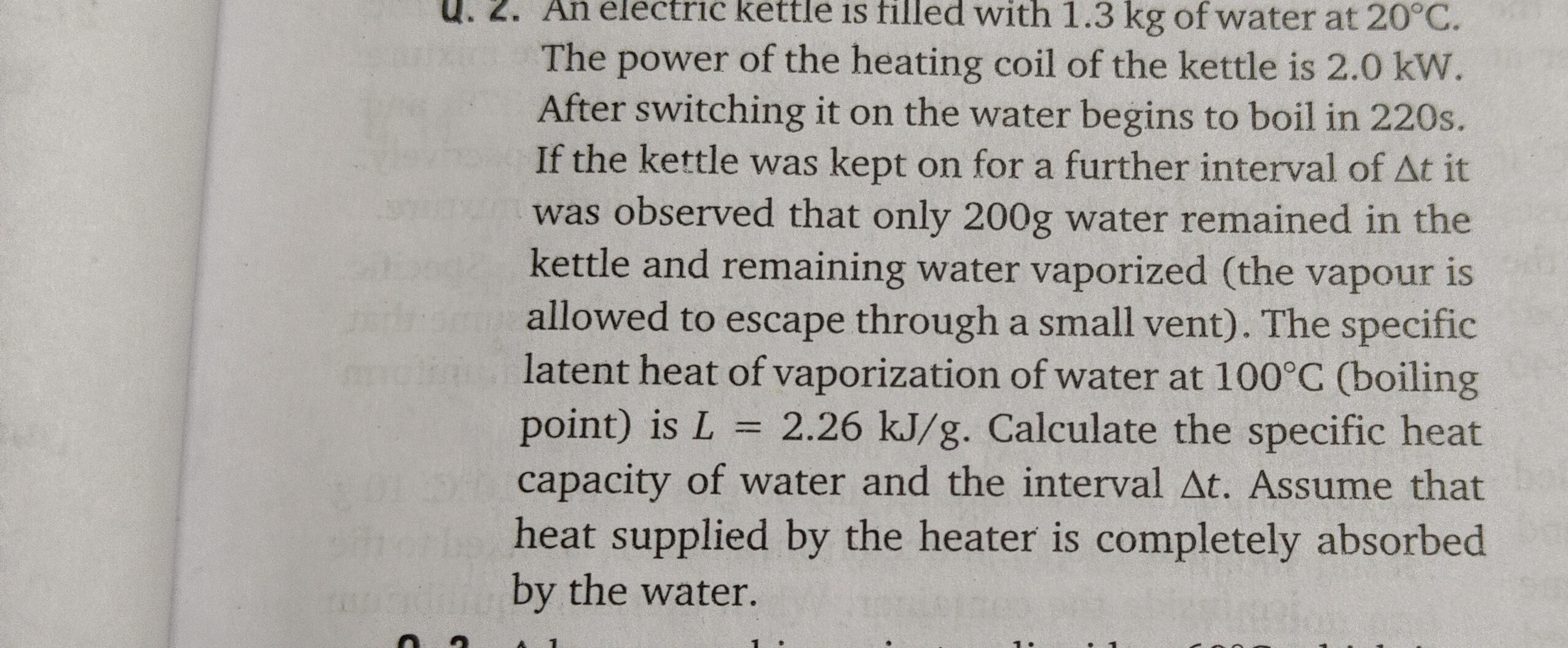Question
Question: An electric kettle is filled with 1.3 kg of water at 20°C. The power of the heating coil of the kett...
An electric kettle is filled with 1.3 kg of water at 20°C. The power of the heating coil of the kettle is 2.0 kW. After switching it on the water begins to boil in 220s. If the kettle was kept on for a further interval of Δt it was observed that only 200g water remained in the kettle and remaining water vaporized (the vapour is allowed to escape through a small vent). The specific latent heat of vaporization of water at 100°C (boiling point) is L=2.26 kJ/g. Calculate the specific heat capacity of water and the interval Δt. Assume that heat supplied by the heater is completely absorbed by the water.

Specific heat capacity of water = 1355000 J/kg°C, Δt = 1243 s
Specific heat capacity of water = 1355000 J/kg°C, Δt = 220 s
Specific heat capacity of water = 4200 J/kg°C, Δt = 1243 s
Specific heat capacity of water = 4200 J/kg°C, Δt = 220 s
Specific heat capacity of water = 1355000 J/kg°C, Δt = 1243 s
Solution
Step 1: Calculate the specific heat capacity of water (cw)
The heat supplied by the kettle in the first 220 seconds is used to raise the temperature of 1.3 kg of water from 20°C to 100°C. Power of the kettle, P=2.0kW=2000W. Time, t1=220s. Heat supplied, Q1=P×t1=2000W×220s=440000J.
The heat required to raise the temperature of water is given by: Q1=m×cw×ΔT where m=1.3kg, and ΔT=100∘C−20∘C=80∘C.
So, 440000J=1.3kg×cw×80∘C. cw=1.3×80440000J/kg∘C=104440000J/kg∘C=1355000J/kg∘C. Approximately, cw≈4230.77J/kg∘C.
Step 2: Calculate the interval Δt
After the water reaches boiling point, the kettle is kept on for an additional time Δt. During this time, a portion of the water vaporizes. Initial mass of water = 1.3 kg. Remaining mass of water = 200 g = 0.2 kg. Mass of water vaporized, mvap=1.3kg−0.2kg=1.1kg.
The specific latent heat of vaporization of water is given as L=2.26kJ/g. Convert L to J/kg: L=2.26kJ/g=2.26×103J/g=2.26×106J/kg.
The heat required to vaporize 1.1 kg of water is: Qvap=mvap×L=1.1kg×2.26×106J/kg=2.486×106J.
This heat is supplied by the kettle during the interval Δt. Heat supplied, Q2=P×Δt=2000W×Δt.
Equating Q2 and Qvap: 2000W×Δt=2.486×106J. Δt=20002.486×106s=20002486000s=1243s.
Therefore, the specific heat capacity of water is 1355000J/kg∘C and the interval Δt is 1243 s.
